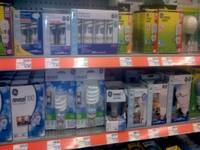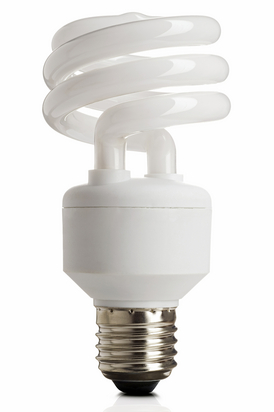Compact fluorescent bulbs - Safe or unsafe?

Photo by: Nicholas Paul
I've been purchasing compact fluorescent light bulbs for a while now to help save energy, but I have recently heard that they are dangerous when they are broken. Is that true? How unsafe are they?
—Sarah S., Ann Arbor
Hi Sarah,
As I tightened the replacement compact fluorescent (CFL) bulb in my bathroom light fixture, I turned to see my 10-year-old daughter walk in and ask, "Whatcha doing?" Slowly I turned to respond, knocking the remaining bulbs onto the floor. Glass fragments everywhere!
Remembering the claims about the dangers of CFL bulbs, I asked my daughter to leave the room, closed the door and went to my favorite digital encyclopedia, (Google), to find the truth about the risk with CFL bulbs. And I am glad I did!
The "Energy Independence and Security Act of 2007" requires certain light bulbs to be more energy efficient by 2012-2014. Studies show that CFL bulbs can last up to 10 times longer than their predecessor incandescent bulbs. Energy Star also rated bulbs that can use 75 percent less electricity. But does all that matter if there is a safety concern?

According to the Environmental Protection Agency, CFL contains a small amount of mercury, an average of 4 milligrams (mg). The average amount of mercury in the old thermometers contained an approximate average of 500 mg — that’s equal to 125 CFL light bulbs.
Mercury is one of the most dangerous substances on earth. Although the amount of mercury is minor, if a CFL bulb breaks, you must clean up the area correctly to help avoid any heath issues. When the mercury escapes after a bulb is broken, it is released as mercury vapor. The EPA recommends the following after a CFL bulb is broken:
Cleanup and Disposal Overview
The most important steps to reduce exposure to mercury vapor from a broken bulb are:
1. Before cleanup:
a. Have people and pets leave the room.
b. Air out the room for 5-10 minutes by opening a window or door to the outdoor
environment.
c. Shut off the central forced air heating/air conditioning (H&AC) system.
d. Collect materials needed to clean up the broken bulb.
2. During cleanup
a. Be thorough in collecting broken glass and visible powder.
b. Place cleanup materials in a sealable container.
3. After cleanup
a. Promptly place all bulb debris and cleanup materials outdoors in a trash container or
protected area until materials can be disposed of properly. Avoid leaving any bulb
fragments or cleanup materials indoors.
b. For several hours, continue to air out the room where the bulb was broken and leave the
heating and air conditioning system shut off.
Disposal location of the CFS can be found at the Environmental Health Division’s website to include Home Depot and Gross Electric in Ann Arbor.
There are CFL bulbs on the market, with manufacturers claiming they help protect us from the dangers of normal CFLs; these products have protective coatings to contain the debris, such as Armorlite, or shatter resistant bulbs. Be sure to check the prices as some are as much as 10 times the price of regular CFL.
As with most things in life, I wouldn’t worry too much about it. Educate yourself and those around you, be prepared, and enjoy the lower electric bills.
Paul is a State of Michigan Licensed Builder. Paul serves as President and founding member of Nationally franchised HandyPro Handyman Service, servicing Washtenaw, Wayne and Oakland Counties. www.handypro.com. Listen to Paul every Saturday at 11 a.m. on “It’s Your Business, Make It Happen” WAAM Talk 1600AM. Email questions or comments to kpaul@handypro.com.


Comments
Brad Buscher
Mon, Dec 5, 2011 : 3:12 p.m.
As this article states, CFLs do contain small amounts of mercury. While it may not be high in quantity, it is still important for consumers to realize that they require special handling. The mercury vapor can be detrimental to handlers' health—from those involved with handling new bulbs to people involved with storing, packaging and shipping used lamps. Mercury vapor, which can be absorbed through the skin or inhaled, can cause neurological damage, and when it gets into water, it can enter the food chain through fish. Read more about the dangers of mercury exposure here: <a href="http://vaporlok.blogspot.com/2010/05/preventing-health-and-safety-hazards.html" rel='nofollow'>http://vaporlok.blogspot.com/2010/05/preventing-health-and-safety-hazards.html</a>. If a bulb is broken or burns out, it should be properly cleaned up and recycled—it should not be disposed of in landfills. To reduce the risk for mercury vapor exposure, CFLs and fluorescent lamps should be safely handled, stored and transported to recycling facilities in a package that is proven to effectively contain hazardous mercury vapor. Find out more about how to minimize environmental risks and safely package CFLs here: <a href="http://vaporlok.blogspot.com/2010/05/layers-of-protection-packaging-used.html" rel='nofollow'>http://vaporlok.blogspot.com/2010/05/layers-of-protection-packaging-used.html</a> If a bulb breaks, consumers can learn more about clean-up procedures here: <a href="http://www.epa.gov/cfl/cflcleanup-detailed.html" rel='nofollow'>http://www.epa.gov/cfl/cflcleanup-detailed.html</a>
Keith A. Paul
Sun, Dec 4, 2011 : 4:10 p.m.
Thanks for everyone's response on this article, email and Facebook. It is definitely a controversial topic where education is the utmost importance. A couple things to point out. 1. According to Popular mechanics <a href="http://www.popularmechanics.com/science/environment/will-led-light-bulbs-best-cfls-and-incandescents" rel='nofollow'>http://www.popularmechanics.com/science/environment/will-led-light-bulbs-best-cfls-and-incandescents</a> LED can last over 25,000 hours as compared to 8-9,000 hours of a cfl. 2. Also thanks to a George, (and Tehnojunkie), an Annarbor.com reader, for the kudo's and for "emphasizing the importance of thoroughly cleaning the area where the bulb broke. Many people think of vacuum cleaning as a way to clean thoroughly. It is important NOT to use a vacuum cleaner, because it will disperse the contamination into the air. "
Keith A. Paul
Sun, Nov 27, 2011 : 8:41 p.m.
Mercury is contained within the bulb itself. But any type of breakage, I would follow the cleaning instructions just to be safe. I agree with you Technojunkie, I am excited about Light - emitting diodes, (LED), lowering to a pricepoint for the masses.
Ann English
Sat, Nov 26, 2011 : 11:52 p.m.
Is the "visible powder" you mention finely crushed glass? Sounds like it was a good thing that when the end of one curly Q light bulb I handled broke off, I was in a very large, well-ventilated area, not in a small room at home. I had thought that nothing came out after the tip broke off, but you're saying that mercurial vapor comes out.
LA
Sat, Nov 26, 2011 : 3:28 p.m.
I think it's a horrible tradeoff. Aside from the quality of the light...I find the health concerns appalling. I'll continue to use incandescent, thank you very much. By the time they are outlawed, hopefully LEDs will be readily be available.
Technojunkie
Fri, Nov 25, 2011 : 3:12 p.m.
I'd worry about it. Mercury vapor is the most dangerous form of the second most toxic element next to uranium. In vapor form mercury can get into the brain easily. How bad mercury is depends on genetics. Some people are very poor at removing heavy metals from their body. People of northern European ancestry are over-represented in this group. This is also why vacuuming up broken mercury thermometers is very bad as that turns it into mercury vapor which your vacuum cleaner will continue to spew until you replace the bag, at least. Young children who are mercury poisoned are at much higher risk for autism. Unfortunately the controversy over vaccines with mercury preservatives has obscured the dominant source of childhood exposure: in utero from mothers with "silver" amalgam dental fillings that are half mercury. The legal status of mercury dental fillings provides a very good introduction to the subject of "regulatory capture". LED bulbs are technically superior to CFLs and contain no mercury. Buy them when they hit a tolerable price point for you. Right now 60W equivalent LED bulbs are about $25.
DBH
Fri, Nov 25, 2011 : 4:11 p.m.
From the story: "Studies show that CFL bulbs can last up to 10 times longer than their predecessor incandescent bulbs. Energy Star also rated bulbs that can use 75 percent less electricity." Any specific info on how LEDs compare to CFLs and incandescents in terms of lifespan and energy use?